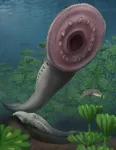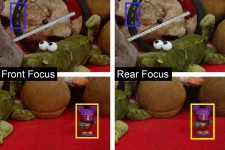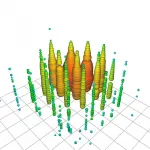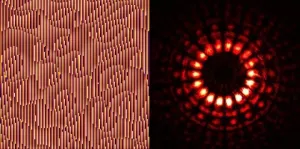(Press-News.org) A new study out of the University of Chicago, the Canadian Museum of Nature and the Albany Museum challenges a long-held hypothesis that the blind, filter-feeding larvae of modern lampreys are a holdover from the distant past, resembling the ancestors of all living vertebrates, including ourselves. The new fossil discoveries indicate that ancient lamprey hatchlings more closely resembled modern adult lampreys, and were completely unlike their modern larvae counterparts. The results were published on March 10 in Nature.
Lampreys -- unusual jawless, eel-like, creatures -- have long provided insights into vertebrate evolution, said first author Tetsuto Miyashita, PhD, formerly a Chicago Fellow at the University of Chicago and now a paleontologist at the Canadian Museum of Nature. "Lampreys have a preposterous life cycle," he said. "Once hatched, the larvae bury themselves in the riverbed and filter feed before eventually metamorphosing into blood-sucking adults. They're so different from adults that scientists originally thought they were a totally different group of fish.
"Modern lamprey larvae have been used as a model of the ancestral condition that gave rise to the vertebrate lineages," Miyashita continued. "They seemed primitive enough, comparable to wormy invertebrates, and their qualities matched the preferred narrative of vertebrate ancestry. But we didn't have evidence that such a rudimentary form goes all the way back to the beginning of vertebrate evolution."
Newly discovered fossils in Illinois, South Africa and Montana are changing the story. Connecting the dots between dozens of specimens, the research team realized that different stages of the ancient lamprey lifecycle had been preserved, allowing paleontologists to track their growth from hatchling to adult. On some of the smallest specimens, about the size of a fingernail, soft tissue preservation even shows the remains of a yolk sac, indicating that fossil record had captured these lampreys shortly after hatching.
Crucially, these fossilized juveniles are quite unlike their modern counterparts (known as "ammocoetes"), and instead look more like modern adult lampreys, with large eyes and toothed sucker mouths. Most excitingly, this phenotype can be seen during the larval phase in multiple different species of ancient lamprey.
"Remarkably, we've got enough specimens to reconstruct a trajectory from hatchling to adult in several independent lineages of early lampreys," said Michael Coates, PhD, a professor in the Department of Organismal Biology and Anatomy at UChicago, "and they each show the same pattern: the larval form was like a miniature adult."
The researchers say that these results challenge the 150-year-old evolutionary narrative that modern lamprey larvae offer a glimpse of deep ancestral vertebrate conditions. By demonstrating that ancient lampreys never went through the same blind, filter-feeding stage seen in modern species, the researchers have falsified this cherished ancestral model.
"We've basically removed lampreys from the position of the ancestral condition of vertebrates," said Miyashita. "So now we need an alternative."
After looking back at the fossil record, the team now believes that extinct armored fishes known as ostracoderms might instead represent better candidates for the root of the vertebrate family tree, whereas modern lamprey larvae are a more recent innovation. The team thinks the evolution of filter-feeding larvae may have allowed lampreys to populate rivers and lakes. Fossil lampreys reported in the new study all came from marine sediments, but modern lampreys mostly live in freshwater.
The researchers say that this is the sort of discovery that can rewrite textbooks. "Lampreys are not quite the swimming time capsules that we once thought they were," said Coates. "They remain important and essential for understanding the deep history of vertebrate diversity, but we also need to recognize that they, too, have evolved and specialized in their own right."
INFORMATION:
The study, "Non-ammocoete larvae of Palaeozoic stem lampreys," was supported by the National Science Foundation (DEB-1541491). The team credits the hard work of their collaborators and co-authors, including Rob Gess, PhD of the Albany Museum in South Africa, with identifying multiple larval fossil samples, and Kristen Tietjen of the University of Kansas with CT scan and life reconstruction of fossil lampreys.
About the University of Chicago Medicine & Biological Sciences
The University of Chicago Medicine, with a history dating back to 1927, is one of the nation's leading academic health systems. It unites the missions of the University of Chicago Medical Center, Pritzker School of Medicine and the Biological Sciences Division. Twelve Nobel Prize winners in physiology or medicine have been affiliated with the University of Chicago Medicine. Its main Hyde Park campus is home to the Center for Care and Discovery, Bernard Mitchell Hospital, Comer Children's Hospital and the Duchossois Center for Advanced Medicine. It also has ambulatory facilities in Orland Park, South Loop and River East as well as affiliations and partnerships that create a regional network of care. UChicago Medicine offers a full range of specialty-care services for adults and children through more than 40 institutes and centers including an NCI-designated Comprehensive Cancer Center. Together with Harvey-based Ingalls Memorial, UChicago Medicine has 1,296 licensed beds, nearly 1,300 attending physicians, over 2,800 nurses and about 970 residents and fellows.
Visit UChicago Medicine's health and science news blog at http://www.uchicagomedicine.org/forefront.
Twitter @UChicagoMed
Facebook.com/UChicagoMed
Facebook.com/UChicagoMedComer
Despite years of hype, virtual reality headsets have yet to topple TV or computer screens as the go-to devices for video viewing. One reason: VR can make users feel sick. Nausea and eye strain can result because VR creates an illusion of 3D viewing although the user is in fact staring at a fixed-distance 2D display. The solution for better 3D visualization could lie in a 60-year-old technology remade for the digital world: holograms.
Holograms deliver an exceptional representation of 3D world around us. Plus, they're beautiful. (Go ahead -- check out the holographic dove on your Visa card.) Holograms offer a shifting perspective based on the viewer's position, and they allow the eye to adjust focal depth to alternately focus on foreground and background.
Researchers have long sought ...
On December 6, 2016, a high-energy particle called an electron antineutrino hurtled to Earth from outer space at close to the speed of light carrying 6.3 petaelectronvolts (PeV) of energy. Deep inside the ice sheet at the South Pole, it smashed into an electron and produced a particle that quickly decayed into a shower of secondary particles. The interaction was captured by a massive telescope buried in the Antarctic glacier, the IceCube Neutrino Observatory.
IceCube had seen a Glashow resonance event, a phenomenon predicted by Nobel laureate physicist ...
Researchers have struck quantum gold--and created a new word--by enlisting machine learning to efficiently navigate a 20-dimensional quantum treasure map.
Physicist Dr Markus Rambach from the ARC Centre of Excellence for Engineered Quantum Systems (EQUS) at The University of Queensland said the team was able to find unknown quantum states more quickly and accurately, using a technique called self-guided tomography.
The team also introduced the 'quvigint', which is like a qubit (the quantum version of a classical bit that takes on the values '0' or '1') except that it takes on not two, but 20 possible values.
Dr ...
What The Study Did: In this study, most risk factors associated with SARS-CoV-2 infection among health care workers were outside the workplace.
Authors: Jesse T. Jacob, M.D., of Emory University in Atlanta, is the corresponding author.
To access the embargoed study: Visit our For The Media website at this link https://media.jamanetwork.com/
(doi:10.1001/jamanetworkopen.2021.1283)
Editor's Note: The article includes conflict of interest and funding/support disclosures. Please see the article for additional information, including other authors, author contributions and affiliations, conflict of interest and financial disclosures, and funding and support.
INFORMATION:
Media ...
MADISON - On December 6, 2016, a high-energy particle hurtled to Earth from outer space at close to the speed of light. The particle, an electron antineutrino, smashed into an electron deep inside the ice sheet at the South Pole. This collision produced a particle that quickly decayed into a shower of secondary particles, triggering the sensors of the IceCube Neutrino Observatory, a massive telescope buried in the Antarctic glacier.
IceCube had seen a Glashow resonance event, a phenomenon predicted by Nobel laureate physicist Sheldon Glashow in 1960. With this detection, scientists provided another confirmation of the Standard Model of particle physics. It ...
What The Study Did: This study of orthodox Jewisha dults across the United States found that socioculturally bound communities experienced early parallel outbreaks in discrete locations, notably prior to substantive medical and governmental directives.
Authors: Jonathan I. Silverberg, M.D., Ph.D., M.P.H., of George Washington University in Washington, D.C., and Avi Z. Rosenberg, M.D., Ph.D., of Johns Hopkins University in Baltimore, are the corresponding authors.
To access the embargoed study: Visit our For The Media website at this link https://media.jamanetwork.com/
(doi:10.1001/jamanetworkopen.2021.2816)
Editor's Note: The article includes conflict of interest and funding/support disclosures. ...
What The Study Did: In a study of Italian close contacts of patients with confirmed SARS-CoV-2 infection, most infected contacts (1,948 of 2,824 individuals or 69%) didn't develop respiratory symptoms or fever 37.5 degrees Celsius (99.5 degrees Fahrenheit) or higher; 26.1% of infected individuals younger than 60 developed respiratory symptoms or fever 37.5 degrees Celsius (99.5 degrees Fahrenheit); and 6.6% of infected participants age 60 or older developed critical disease.
Authors: Piero Poletti, Ph.D., of Fondazione Bruno Kessler in Trento, ...
What The Study Did: Boston experienced a COVID-19 surge that disproportionately affected persons experiencing homelessness and a large safety-net hospital implemented a novel COVID-19 recuperation unit for these patients that provided isolation, quarantine and treatment for substance use. Researchers aimed to determine the association of the care provided by the unit with COVID-19 hospitalizations among people experiencing homelessness.
Authors: Joshua A. Barocas, M.D., of Boston Medical Center, is the corresponding author.
To ...
What The Study Did: Findings of this study suggest that patients recovering from COVID-19-associated acute kidney injury require monitoring of kidney function following hospital discharge.
Authors: F. Perry Wilson, M.D. M.S.C.E., of the Yale University School of Medicine in New Haven, Connecticut, is the corresponding author.
To access the embargoed study: Visit our For The Media website at this link https://media.jamanetwork.com/
(doi:10.1001/jamanetworkopen.2021.1095)
Editor's Note: The article includes conflict of interest and funding/support disclosures. Please see the article for additional information, including other authors, author ...
In the first study of the genomic architecture of the human placenta, scientists at the Wellcome Sanger Institute, the University of Cambridge and their collaborators have confirmed that the normal structure of the placenta is different to any other human organ and resembles that of a tumour, harbouring many of the same genetic mutations found in childhood cancers.
The study, published today (10 March 2021) in Nature, found evidence to support the theory of the placenta as a 'dumping ground' for genetic defects, whereas the fetus corrects or avoids these errors. The findings provide a clear rationale for studying the association between genetic aberrations and birth outcomes, in order to better understand problems such as premature birth and stillbirth.
In the earliest ...



